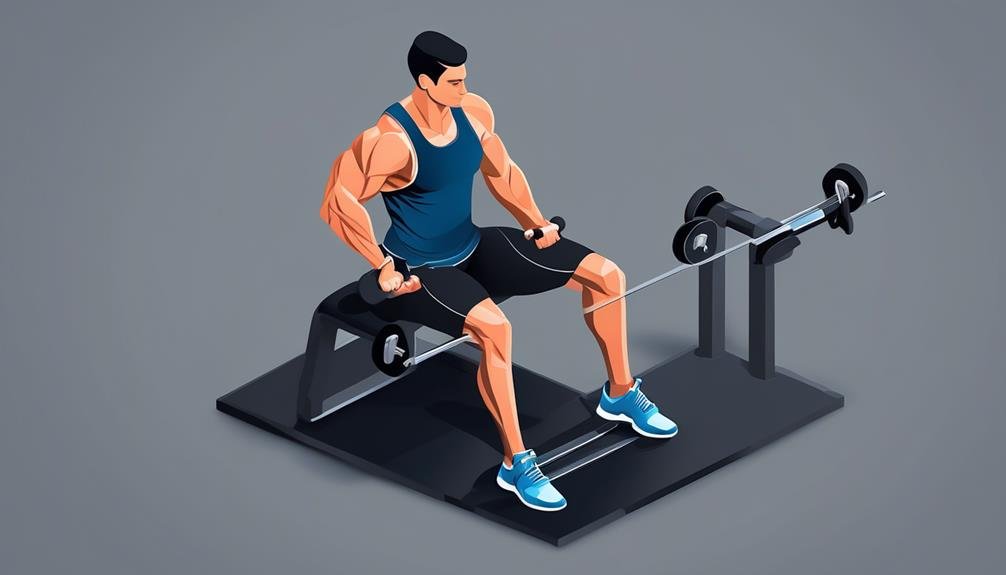Have you ever wondered if it's possible to safely lift heavy weights despite having preexisting injuries? Well, the truth is, with the right approach and precautions, it can be done.
Whether you're dealing with a bad back, a shoulder injury, or any other condition, there are steps you can take to ensure a safe and effective workout.
In this discussion, we will explore various strategies and techniques that will allow you to lift heavy weights while minimizing the risk of aggravating your preexisting injuries.
So, let's dive in and discover how you can achieve your fitness goals without compromising your health and well-being.
Key Takeaways
- Consult with a qualified healthcare professional before starting weightlifting to assess your injuries and get guidance.
- Gradually increase weight and intensity while paying attention to form and technique.
- Implement modifications and alternative exercises to engage muscles without excessive strain.
- Listen to your body, stop if feeling sharp or shooting pain, and incorporate rest and recovery into your routine.
Understanding Your Preexisting Injuries
Understanding your preexisting injuries is essential before attempting to lift heavy weights safely. It's crucial to have a comprehensive understanding of the specific nature of your injuries, as well as how they might be affected by weightlifting. This knowledge will help you develop a safe and effective lifting routine that accommodates your limitations while still allowing you to make progress.
First and foremost, consult with a qualified healthcare professional who can assess your injuries and provide guidance on how to proceed. They can offer insights into the specific movements or exercises that may aggravate your injuries, as well as recommend modifications or alternative exercises that can minimize the risk of further harm.
Additionally, take the time to educate yourself about your injuries. Research the anatomy and mechanics involved, and how they relate to lifting heavy weights. This knowledge will enable you to make informed decisions about which exercises to prioritize or avoid altogether. Remember, understanding your injuries empowers you to make modifications to your lifting routine that can protect your body and prevent exacerbation of your preexisting conditions.
Lastly, be honest with yourself about your limitations and listen to your body. Pushing through pain or ignoring warning signs can lead to further injury. It's crucial to always prioritize your safety and well-being over lifting heavier weights. Remember, progress is a journey that requires patience and consistency, and it can still be achieved even with preexisting injuries.
Consulting With a Medical Professional
Before embarking on a weightlifting journey with preexisting injuries, it's essential to consult with a qualified medical professional. They'll have the expertise to assess your specific condition and provide personalized guidance to ensure your safety throughout your weightlifting journey.
When you consult with a medical professional, they'll conduct a thorough evaluation of your injuries and medical history. They'll consider factors such as the type and severity of your injuries, any underlying conditions, and your overall physical fitness. Based on this assessment, they'll be able to offer recommendations on the types of exercises you can safely perform, as well as modifications or precautions you may need to take.
It is important to be open and honest with your medical professional about your goals and expectations. They'll be able to provide realistic advice and set appropriate goals for your weightlifting journey. They may also refer you to other specialists, such as physical therapists, who can work with you to develop a personalized exercise program.
Incorporating Proper Warm-Up and Stretching Techniques

To ensure a safe and effective weightlifting session, it's crucial to incorporate proper warm-up and stretching techniques. Before diving into heavy lifting, it's important to prepare your body for the physical demands it's about to face. A proper warm-up increases blood flow to the muscles, raises your body temperature, and activates your nervous system, all of which help to reduce the risk of injury.
Start your warm-up with some light cardio exercises, such as brisk walking or cycling, for about 5-10 minutes. This will increase your heart rate and get your muscles warmed up. Next, move on to dynamic stretching, which involves moving your joints through a full range of motion. Perform exercises like arm circles, leg swings, and trunk rotations to mobilize your muscles and loosen up any tightness.
After completing your warm-up, it's time to focus on static stretching. This involves holding stretches for 15-30 seconds to improve flexibility and elongate your muscles. Target the major muscle groups used during weightlifting, such as the shoulders, back, legs, and hips. Remember to breathe deeply and relax into each stretch, avoiding any bouncing or jerking movements.
Incorporating proper warm-up and stretching techniques not only prepares your body for the demands of heavy lifting but also helps to enhance your overall performance. By taking the time to properly warm up and stretch, you're setting yourself up for success and reducing the risk of injury.
Gradually Increasing Weight and Intensity
Now that you have properly warmed up and stretched your muscles, it's time to gradually increase the weight and intensity of your lifting routine. This step is crucial for building strength and making progress, but it's important to do it safely, especially if you have preexisting injuries.
To start, you should begin with a weight that's comfortable and manageable for you. It's better to start lighter and gradually work your way up rather than jumping into heavy weights right away. This allows your body to adapt and prevents unnecessary strain or injury.
As you continue your workouts, aim to increase the weight incrementally, adding only a small amount at a time. This slow progression will give your body the opportunity to adapt and get stronger without overwhelming it.
It's also important to pay attention to your form and technique as you increase the weight. Make sure you maintain proper alignment and engage the correct muscles throughout each exercise. If you notice any pain or discomfort, listen to your body and adjust accordingly.
Don't hesitate to consult with a fitness professional or a physical therapist who can provide guidance tailored to your specific needs.
Implementing Modifications and Alternative Exercises

When incorporating modifications and alternative exercises into your lifting routine, it's essential to consider your preexisting injuries and find suitable options to prevent further strain or discomfort. Making these adjustments will allow you to continue working toward your fitness goals while minimizing the risk of exacerbating existing conditions.
One modification you can consider is reducing the weight you lift. By decreasing the load, you can still engage your muscles without putting excessive strain on your joints or vulnerable areas.
Another option is adjusting your grip or hand position. For example, if you have wrist pain, using dumbbells instead of a barbell can provide more wrist support.
Additionally, you can explore alternative exercises that target the same muscle groups but put less stress on your injuries. For instance, if you have knee issues, substituting squats with leg presses or lunges can help you build strength without aggravating your knees.
Remember to consult with a qualified fitness professional or physical therapist who can guide you in finding the most suitable modifications and alternative exercises for your specific needs. They can provide personalized recommendations and ensure you maintain proper form to prevent further injury.
Using Proper Form and Technique
Proper form and technique are essential when lifting heavy weights, especially if you have preexisting injuries. By using the correct form, you can minimize the risk of further injury and maximize the benefits of your workout. Here are three key points to keep in mind when it comes to using proper form and technique:
- Maintain a neutral spine: Keeping your spine in a neutral position is crucial for avoiding unnecessary strain on your back. Engage your core muscles and imagine a straight line running from your head to your tailbone throughout the exercise.
- Control the movement: Take your time and focus on controlling the weight throughout the entire range of motion. Avoid using momentum or jerky movements, as they can increase the risk of injury. Remember to breathe steadily and exhale during the exertion phase of the exercise.
- Use the appropriate grip: Depending on the exercise, there may be different grips that can help you maintain proper form. For example, when performing a deadlift, an overhand grip or a mixed grip can provide better stability and prevent the barbell from slipping out of your hands.
Listening to Your Body and Adjusting Accordingly

To ensure a safe and effective workout, it's crucial to listen to your body and make necessary adjustments, especially if you have preexisting injuries and are lifting heavy weights with proper form and technique. Your body is the best indicator of what it can handle, so pay attention to any discomfort or pain during your workout. If you feel any sharp or shooting pain, it's important to stop immediately and assess the situation. Pushing through the pain can lead to further injury and setbacks in your fitness journey.
When it comes to adjusting your workout, it's essential to be flexible and adaptive. If you notice that a certain exercise is causing discomfort or aggravating your preexisting injury, don't be afraid to modify or substitute it with a safer alternative. For example, if you have a shoulder injury and bench presses are causing pain, you can try using dumbbells instead or focus on exercises that target different muscle groups.
Additionally, it's crucial to pace yourself and not overexert your body. Gradually increase the weight and intensity of your workouts, allowing your body to adapt and strengthen over time. Remember, progress takes time, and safety should always be your top priority.
Frequently Asked Questions
Are There Any Specific Exercises That I Should Avoid if I Have Preexisting Injuries?
If you have preexisting injuries, it's important to avoid any exercises that could worsen or aggravate them. Consult with a healthcare professional to determine which specific exercises you should avoid to ensure your safety while lifting heavy weights.
How Often Should I Consult With a Medical Professional if I Have Preexisting Injuries?
You should consult with a medical professional regularly if you have preexisting injuries. It's important to have their guidance and expertise to ensure you're lifting weights safely and not exacerbating your condition.
Can I Still Lift Heavy Weights if I Have a Chronic Condition or Illness?
Yes, you can still lift heavy weights if you have a chronic condition or illness. However, it is important to consult with a medical professional to develop a safe and effective exercise plan that takes your condition into account.
Are There Any Supplements or Medications That Can Help With Lifting Heavy Weights Safely With Preexisting Injuries?
To lift heavy weights safely with preexisting injuries, focus on proper form, start with lighter weights, and gradually increase the load. Consult with a healthcare professional for exercises and modifications tailored to your specific condition.
What Are Some Common Mistakes to Avoid When Lifting Heavy Weights With Preexisting Injuries?
To safely lift heavy weights with preexisting injuries, avoid common mistakes like lifting too much weight, using poor form, and not allowing for proper rest and recovery. Listen to your body and modify exercises as needed.
Conclusion
In conclusion, when it comes to safely lifting heavy weights with preexisting injuries, it's crucial to prioritize your health and consult with a medical professional. Incorporating proper warm-up and stretching techniques, gradually increasing weight and intensity, implementing modifications and alternative exercises, using proper form and technique, and listening to your body are all essential steps to protect yourself from further injury.
Remember, taking care of your body should always be the top priority in any fitness journey.







